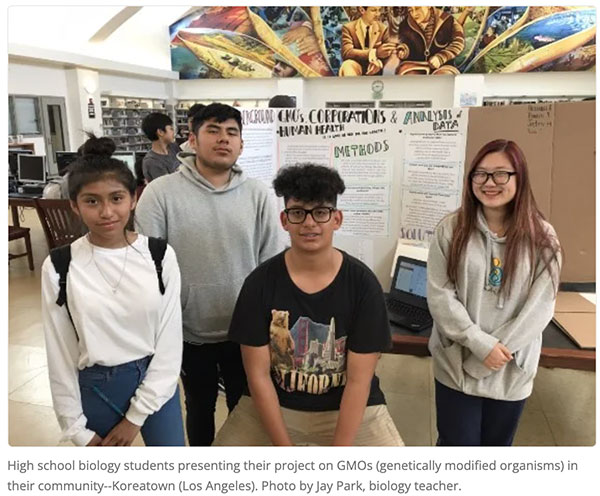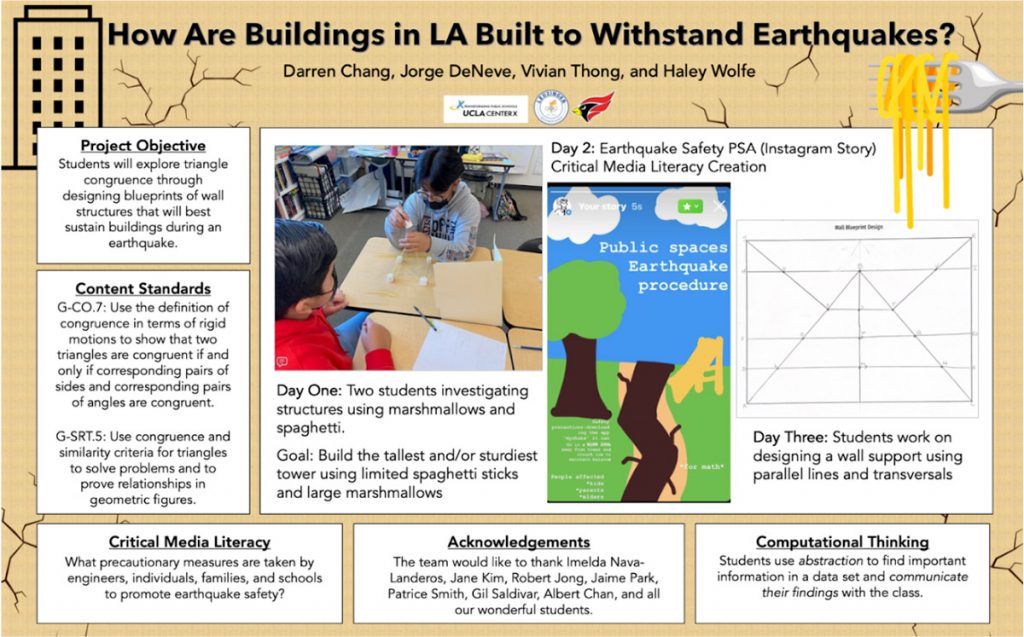
Project-Based Learning for
THE BRIEFING ROOM
This section gives a general overview of how the UCLA Teacher Education Program (TEP) prepares secondary mathematics and science teacher candidates on PBL and equity. In Understanding How Pre-Service Teachers Learn PBL for Social Justice, teacher educators learn that all educators, including pre-service teachers, can engage in PBL with their students, given a community of collaborators, mentors, and programmatic programmatic supports.
- UCLA Teacher Education Program Secondary Math and Science Pre-service Teacher PBL Showcase Event
- How Can Pre-service STEM Teachers Enact Project-Based Learning for Authentic Community Engagement?
- Understanding How Pre-Service Teachers Learn PBL for Social Justice (Paper & Poster)
- Pre-Service STEM Teachers and Their Enactment of Community-STEM-Project-Based Learning
- Sample Poster: How Are Buildings in LA Built to Withstand Earthquakes?
UCLA Teacher Education Program Secondary Math and Science Pre-service Teacher PBL Showcase Event
The Project Based Learning (PBL) assignment was an opportunity to explore a student-centered and interdisciplinary instructional approach and to learn from students through a process of listening and honoring the knowledge, experiences, and voices of those in their community. These projects were completed with three to four people on each team, with TEP Graduates as PBL mentors to provide support and feedback. As a culminating activity, the pre-service teachers presented their work at this PBL Showcase event.
How Can Pre-service STEM Teachers Enact Project-Based Learning for Authentic Community Engagement?
AUTHORS
Jaime Park and Imelda Nava
ABSTRACT
A “Community Teacher” is a conceptual framework for preparing exemplary urban teachers (Murrell, 2000; Francois & Kawasaki, 2021) and highlights the “multicultural competence” teachers need to have. A significant part of this work entails teachers’ reflections on their own identities with the aim of centering the students’ culture and practices in teaching and learning. We began with these questions: How do pre-service STEM teachers enact project-based learning pedagogy that aligns with authentic community engagement and deep understanding? How can teachers use students’ lived experiences, their community, and familial and cultural assets in mathematics and science classrooms? Guided by the work of Bartolomé, 1994 (humanizing pedagogy), Ladson-Billings, 2009 (culturally relevant pedagogy), Ferlazzo, 2016 (culturally sustaining pedagogy), and Darling-Hammond et al., 2019 (deep learning), we developed C-STEM-PBL (Community-focused STEM project-based learning).

Understanding How Pre-Service Teachers Learn PBL for Social Justice (Paper & Poster)
AUTHORS
Jaime Park, Imelda Nava, and Jane Kim
ABSTRACT
Project-Based Learning (PBL) benefits minority students from low-income backgrounds in math and science classrooms; however, less is known about how pre-service teachers learn PBL and its impact in the classroom. Pre-service teachers explored student-centered, interdisciplinary approaches by listening and honoring the knowledge, experiences, and voices of their students and the community. Through a qualitative approach, we deduce themes on the participation of the pre-service teachers and their students and their enactment of PBL. Despite having a lack of experience with PBL, pre-service teachers felt intra-peer validation and support from professional learning communities. They operationalized their notions of equity and social justice and noticed positive differences in content engagement and more student participation in whole-class discussions.
POSTER
Click the image to view a pdf version.
Pre-Service STEM Teachers and Their Enactment of Community-STEM-Project Based Learning (C-STEM-PBL)
AUTHORS
Imelda Nava and Jaime Park
ABSTRACT
Effective K-12 STEM teachers are essential to the critical analysis of real-world issues and can contribute to the democratization of our society. Thus, we engage pre-service math and science teachers in community-focused STEM project-based learning (C-STEM-PBL) so they can integrate community assets, voices, and needs into their pedagogical practice. In this context, pre-service STEM teachers engage K-12 students by connecting STEM-related issues to their personal and community experiences. Further, this place-based, high-context approach creates opportunities for critical analysis; so, students might push against the injustices that affect the community. This model presents access to the third space of teacher development, one with the potential to engage urban-situated STEM teachers in the community.
This is an electronic version of the article published in the Journal of Higher Education Theory and Practice; West Palm Beach Vol. 21, Iss. 9, (2021): 217-237. The Journal of Higher Education is available online at: https://www.proquest.com/docview/2579423687
Interdisciplinary Project: How Are Buildings in LA Built to Withstand Earthquakes?
AUTHORS
Darren Chang, Jorge DeNeve, Vivian Thong, and Haley Wolfe
DESCRIPTION
This interdisciplinary project was created by TEP students during their first year of student teaching. Student teachers incorporated Geometry, Critical Media Literacy and Computational Thinking to create a project assignment where students apply triangle congruence and abstraction to design blueprints of wall structures and present what precautionary measures might be taken by multiple stakeholders, engineers, individuals, families and schools, to promote safety in their community.
POSTER
Click the image to view it larger.
Project-Based Learning for Centering Student Voice in STEM
All XChange Issues
- Project-Based Learning for Centering Student Voice in STEM
- 10 Years of the IMPACT Teacher Residency Program
- Coaching Across a Continuum: A Journey of Learning
- Ethnic Studies K-12
- The Power of Urban Teacher Residencies: The Impact of IMPACT
- Teacher Collaborative Inquiry
- Culturally Relevant Teaching
- Growing and Supporting Teacher Leadership
- Multiple Measures of Good Teaching
- Repertoires of Linguistic Practice
- Critical Uses of Media & Technology
- 15 Years of Lessons Learned

